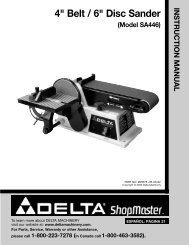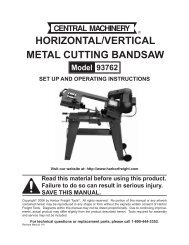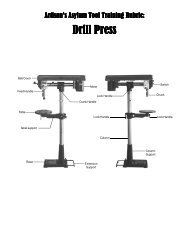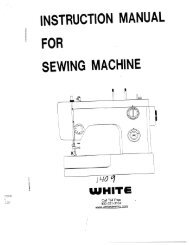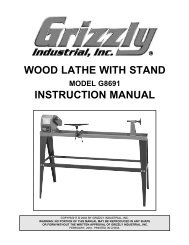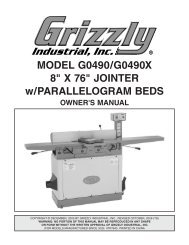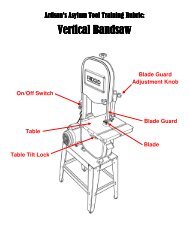You also want an ePaper? Increase the reach of your titles
YUMPU automatically turns print PDFs into web optimized ePapers that Google loves.
ASSEMBLY<br />
• Replace throat plate and table pin.<br />
• Transportation and handling may have caused some<br />
fasteners to loosen. Before operating, check all screws,<br />
bolts and nuts to make sure they are snug. Operate<br />
machine only after reading the entire operator's manual<br />
including blade tracking, blade guide adjustments, and<br />
safety rules.<br />
ADJUSTING BLADE TENSION<br />
See Figures 27 - 28.<br />
As you become familiar with the saw, you may find it necessary<br />
to change the blade tension from the initial setting. Changes<br />
in blade width and the type of material being cut will have<br />
an effect on blade tension.<br />
Keep in mind that too little or too much blade tension can<br />
cause blade breakage.<br />
• Unplug the saw and remove switch key.<br />
• Turn blade tension knob clockwise to tension blade. A<br />
gauge on the upper wheel slide bracket indicates the<br />
approximate tension according to the width of the blade.<br />
Initially, set the blade tension gauge to correspond with<br />
the blade width.<br />
NOTE: Adjustments of blade tension can be made at<br />
anytime.<br />
Another method of checking blade tension has to do with<br />
the sound the blade makes when plucked like a guitar<br />
string.<br />
• Pluck the back straight edge on the coasting side<br />
opposite the blade guides while turning the tension<br />
knob. Sound should be a musical note. Sound becomes<br />
higher pitched as tension increases.<br />
Using either method to check blade tension can be<br />
developed with practice.<br />
• Never increase blade tension so tight as to completely<br />
compress the spring. When completely compressed,<br />
the spring can no longer act as a shock absorber.<br />
TRACKING THE BLADE<br />
See Figure 29.<br />
Blade must be properly tensioned before adjusting blade<br />
tracking. Make sure blade guides and blade bearings do<br />
not interfere with the blade.<br />
• Open upper cover. Rotate the wheel forward by hand and<br />
observe the position of the blade on the wheel. It should<br />
be in the center.<br />
• If adjustment is necessary, loosen wing nut, tighten knob<br />
slightly to move blade toward rear of machine. Slightly<br />
loosening the knob will cause the blade to track toward<br />
the front of the machine.<br />
• Tighten nut after blade is tracking in the center of the<br />
wheel.<br />
BLADE<br />
TENSION<br />
KNOB<br />
TO TIGHTEN<br />
WING NUT<br />
TO LOOSEN<br />
GAUGE<br />
Fig. 27<br />
GAUGE<br />
Fig. 28<br />
21<br />
TRACKING KNOB<br />
Fig. 29



